MSI R9 280 GAMING 3G Graphics Card Review: Best Deal

We’ve finally managed to lay our hands on the graphics card that is potentially the best in terms of price/performance ratio. Today we’re going to check out if the Radeon R9 280 is indeed unrivaled in its category.
In early 2012 AMD rolled out the Radeon HD 7950, the junior cousin to the company’s then-flagship Radeon HD 7970. The release provoked an excitement in the overclocking community because some samples of the card with Tahiti GPU, those with the reference design in the first place, could be unlocked to the level of a Radeon HD 7970 and then overclocked quite a bit, too. So, for the recommended $449 you might get a full-featured Radeon HD 7970 that cost $100 more.
It is no secret that AMD’s new Radeon R9 and R7 product series announced in October 2013 includes a renamed Radeon HD 7970 GHz Edition which is now known under the model name of Radeon R9 280X. The Radeon HD 7950, in its turn, was supposed to be replaced by a Radeon R9 280, yet the latter card was delayed although its recommended price was dropped from $279 to $249 almost right after its announcement in March 2014.
Thus, what we are offered now is actually a Radeon HD 7950 that costs only about half as much as in 2012 and comes with much higher clock rates in the pre-overclocked versions. We’re going to test one such version today. It is the Radeon R9 280 Gaming 3GB model from MSI.
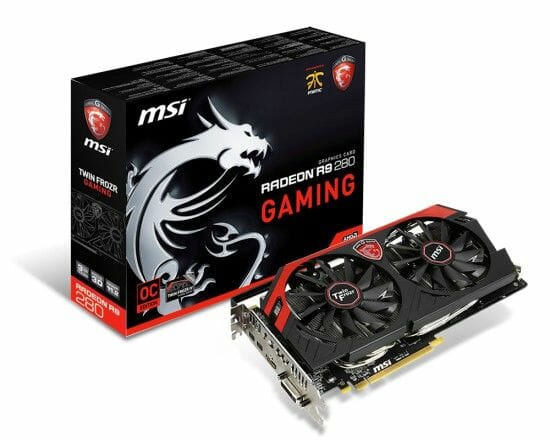
It must be noted right away that there will be no reference Radeon R9 280 cards available because all manufacturers have developed custom PCBs (or just borrowed them from existing Radeon R9 280X products) and pre-overclocked the GPU. We also have no information about whether the R9 280 can be unlocked to the level of the R9 280X because such cards have begun to sell just recently, so there are yet no reports from the overclocking community.
Specifications and Recommended Price
The specs and price of the MSI Radeon R9 280 Gaming are listed in the table in comparison with the closest products in MSI’s product range: MSI Radeon R9 280X Gaming and MSI Radeon R9 270X Gaming.
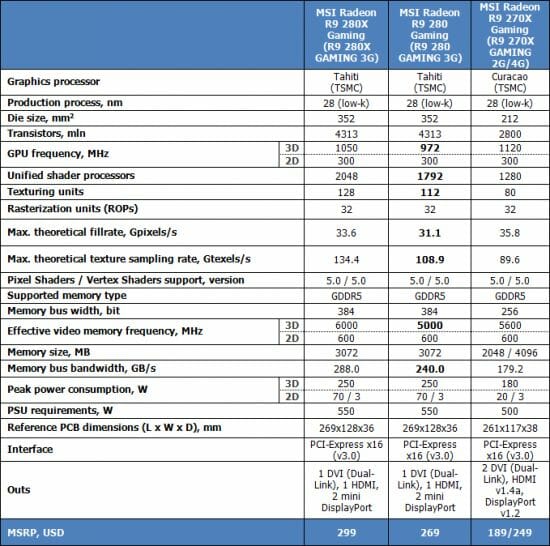
We’ve got the card in OEM packaging, so let’s get to checking out its PCB right away.
PCB Design and Features
The graphics card is designed in MSI’s easily recognizable Gaming series style. There’s the exclusive Twin Frozr IV Advanced cooler covering the entire face side of the PCB. The cooler is about the same size as the PCB itself.
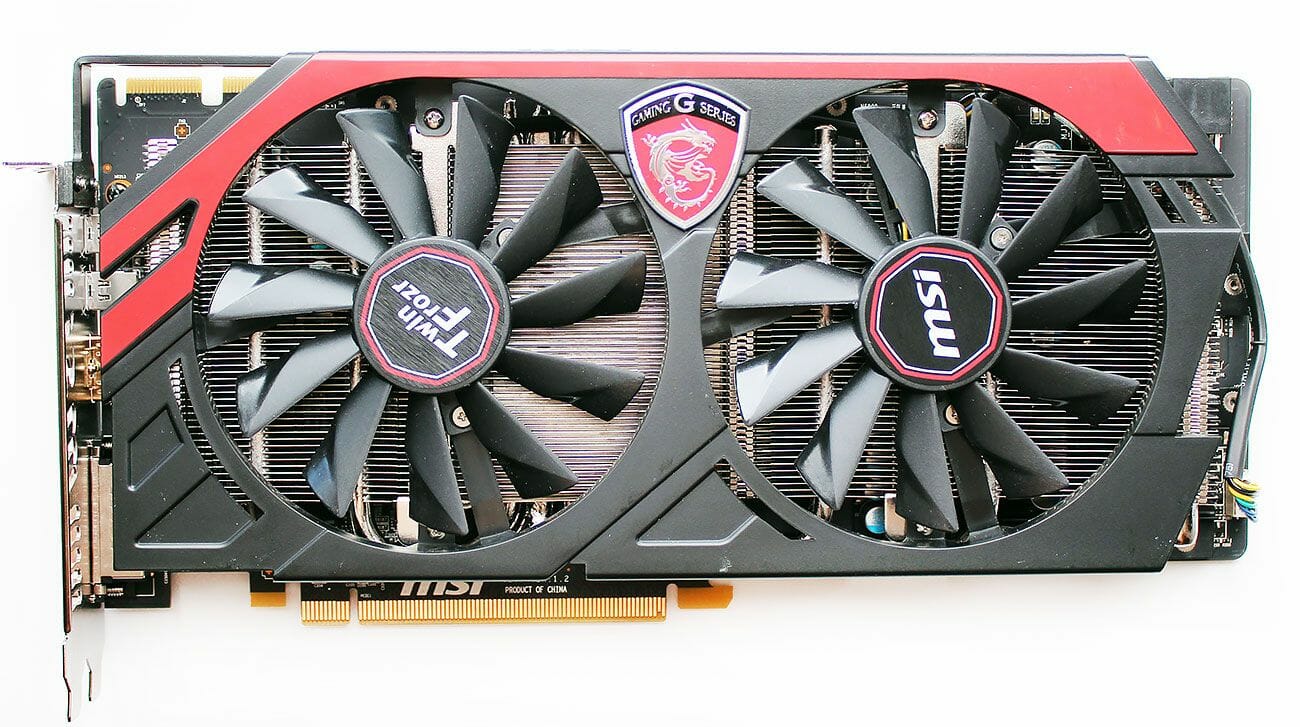
The card measures 269x128x36 millimeters. With this height, you can use a couple of such cards in a CrossFireX configuration even in two adjacent PCIe slots.
Like the senior R9 280X model or the old HD 7970 and 7950, the new card has one dual-link DVI-I output, one HDMI version 1.4a, and two mini-DisplayPorts 1.2.
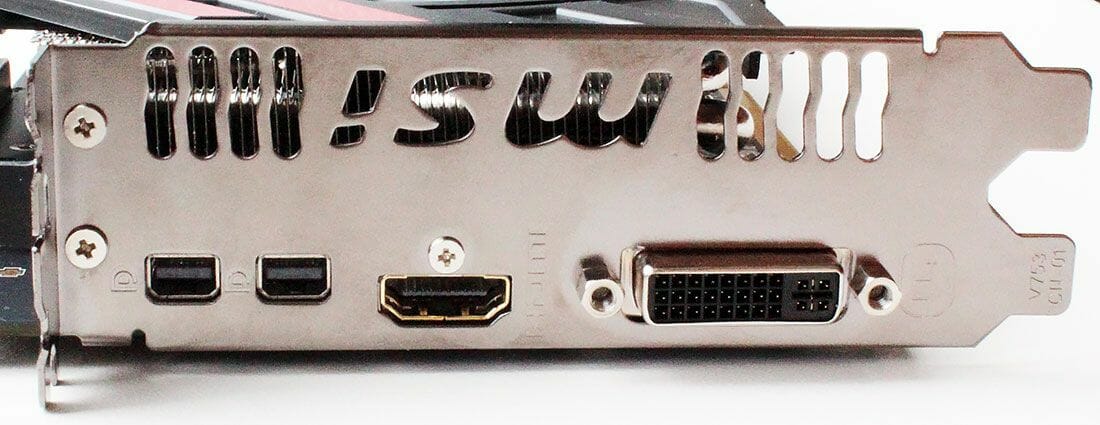
The HDMI connector features gold sputter coating which is supposed to minimize EMI and improve signal quality as MSI claims.
There are two CrossFireX connectors in their conventional location. Next to them, there’s a BIOS switch.
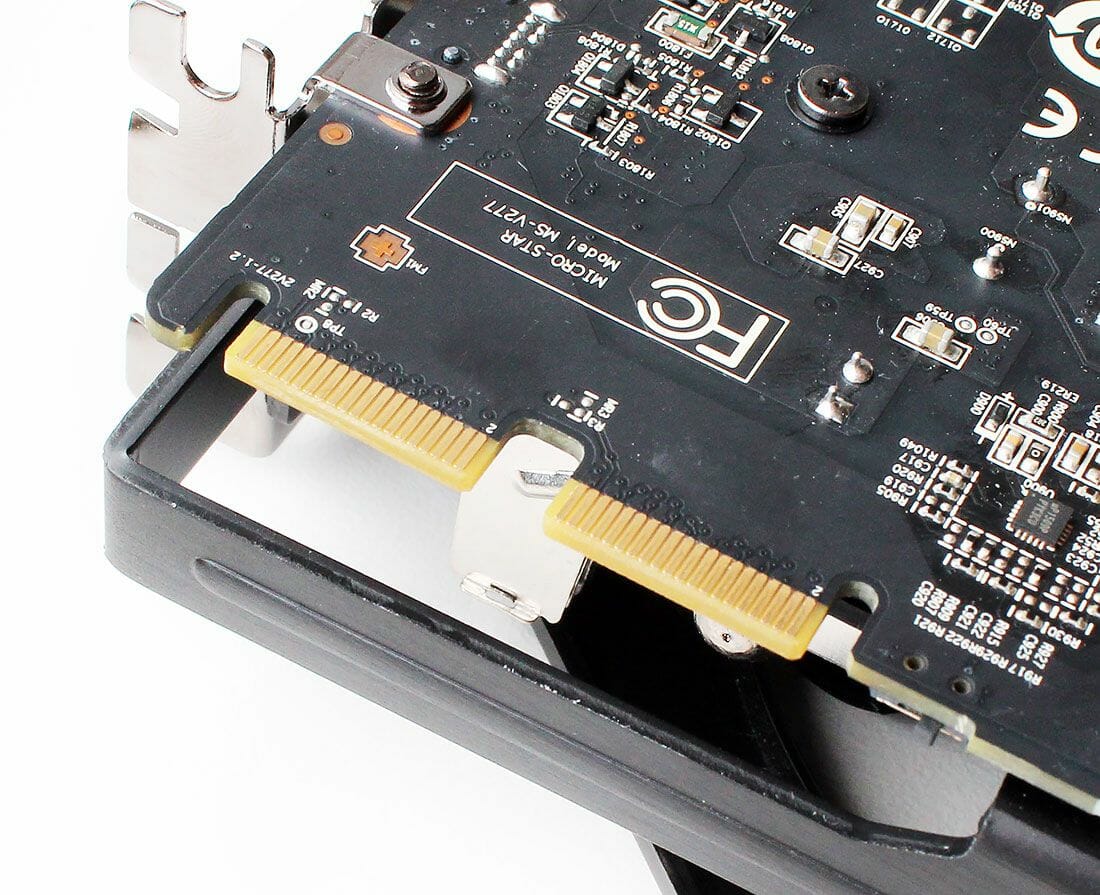
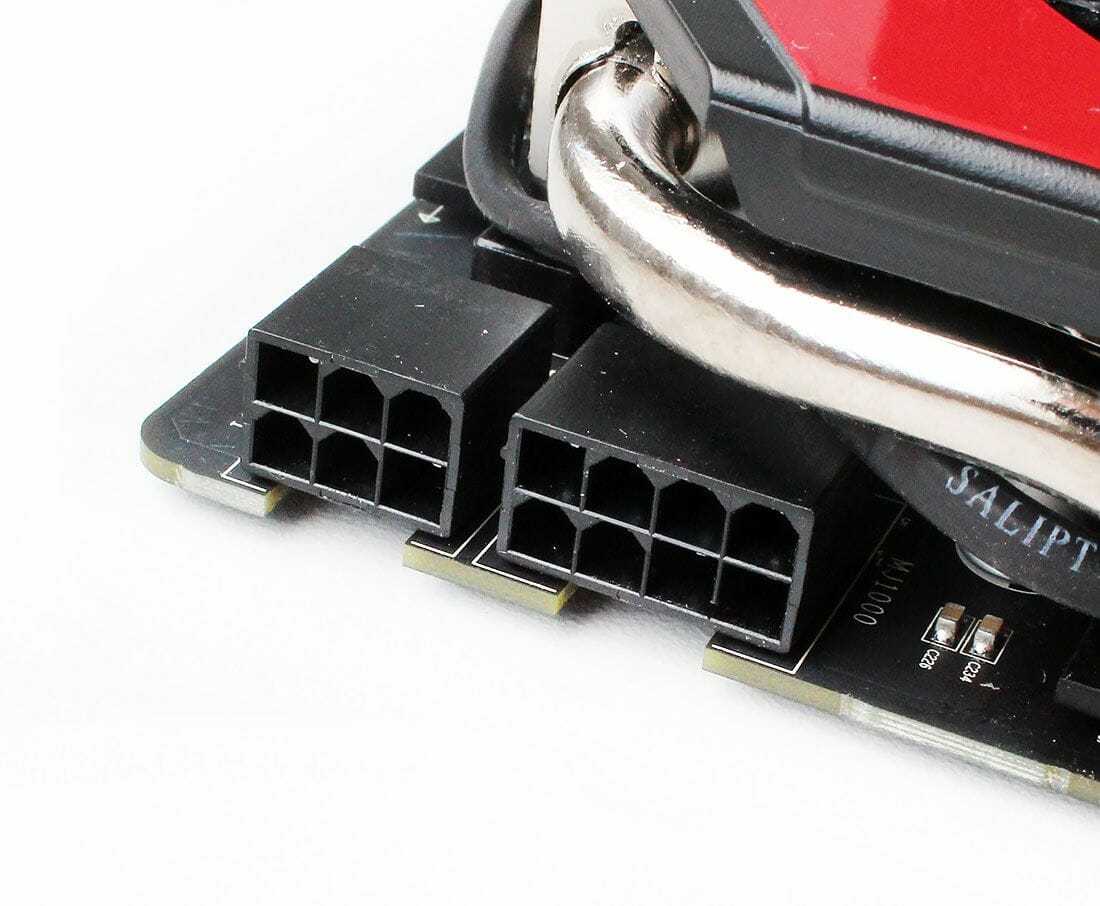
Also in their habitual place, there are one 6- and one 8-pin power connectors. The Radeon R9 280 is specified to need up to 250 watts of power, exactly like the Radeon R9 280X and about 25 watts more than the Radeon HD 7950. The card is going to consume 3 to 70 watts in 2D applications. A 550-watt or better PSU is recommended for a computer with one such graphics card inside.
The cooling system is secured with four screws around the GPU. Beneath it, we can find a heat-spreading plate and a small heatsink on the power system components.
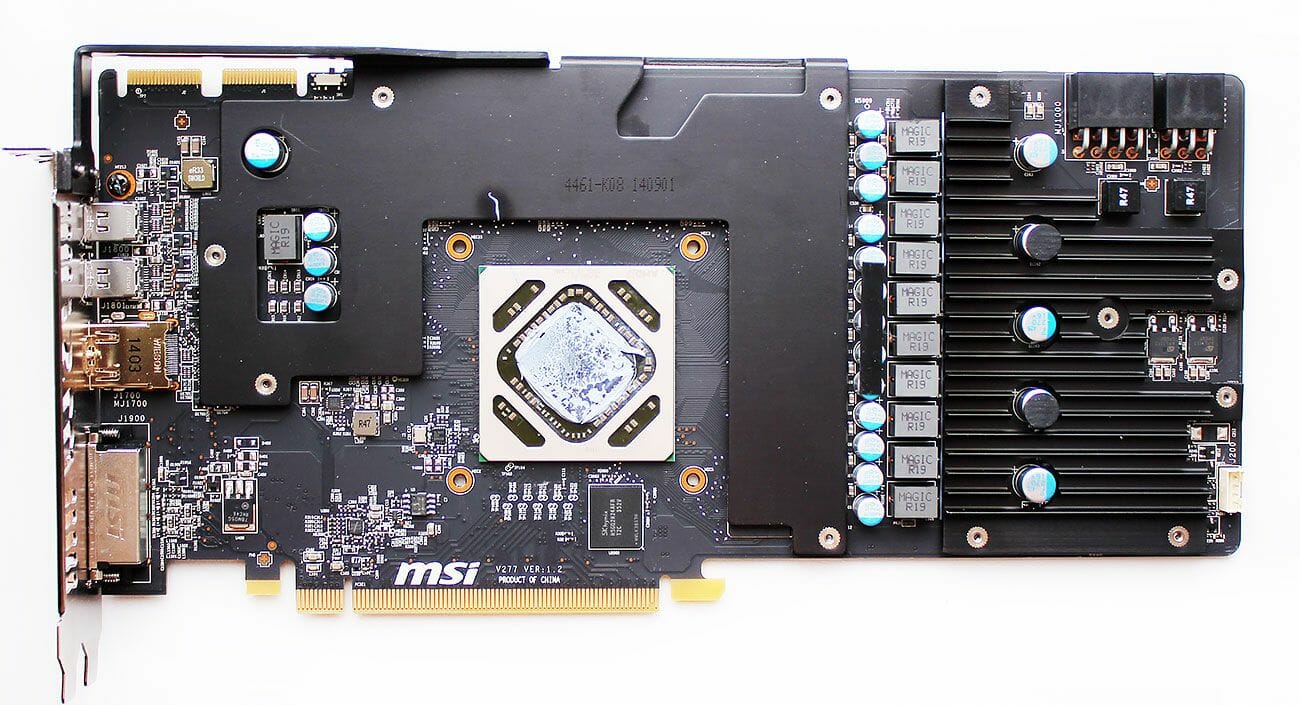
To fully “undress” the card, we need to unfasten a few more screws including those on the mounting bracket.
The PCB layout seems to be the same as with the MSI Radeon R9 280X Gaming which uses the reference Radeon HD 7970 design, yet this PCB is different.
The power system consists of 11 phases, ten of which are located to the right of the GPU in a neat column. One more phase can be found near the mounting bracket. The GPU seems to use eight out of these ten DirectFET power phases.
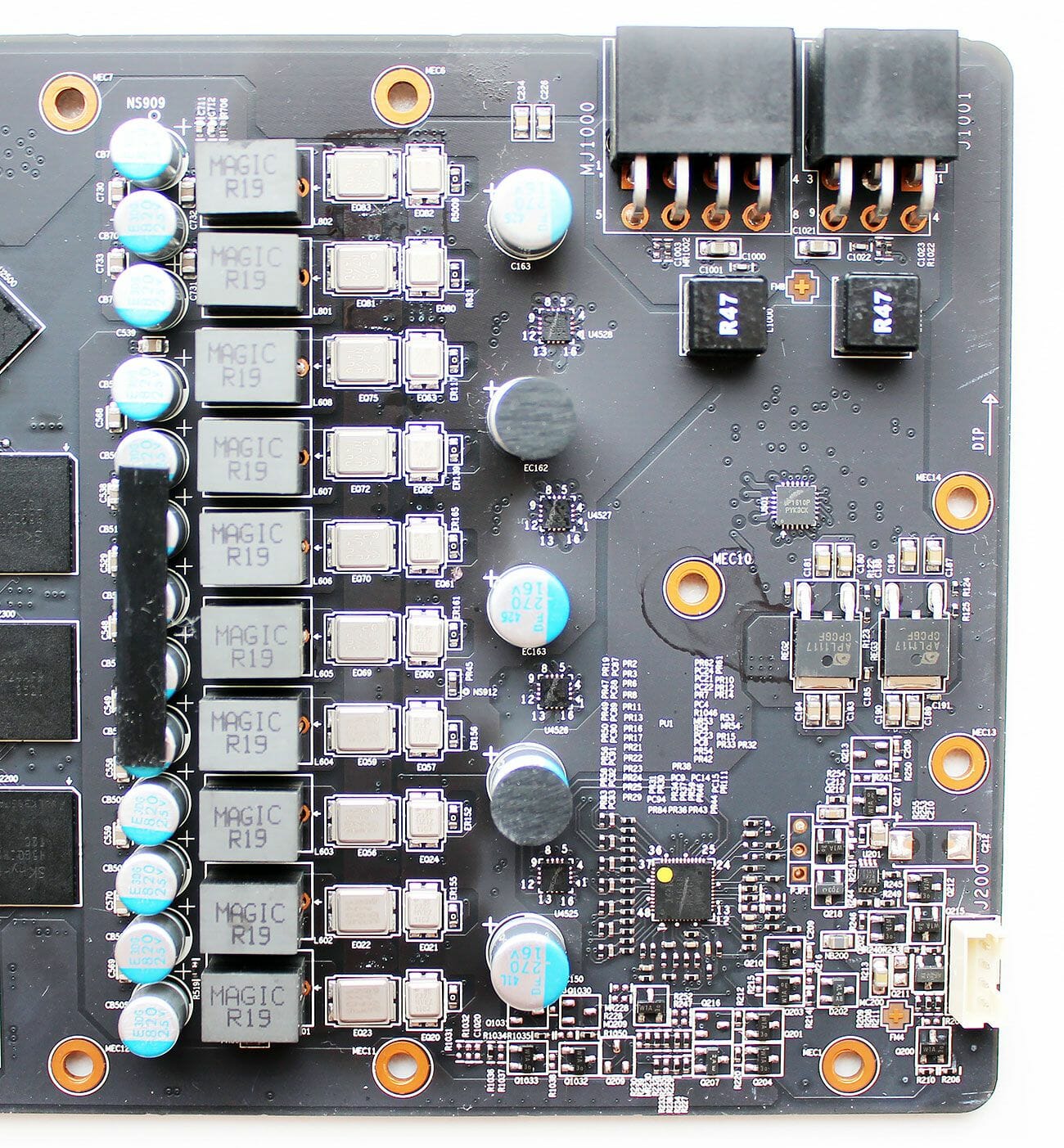
The remaining 2+1 phases are responsible for the memory chips and PLL. Overclockers should appreciate the fact that the Radeon R9 280 has a more advanced power system than the Radeon R9 280X. Moreover, all of the card’s components comply with the American Military Class IV standard (MIL-STD-810G).
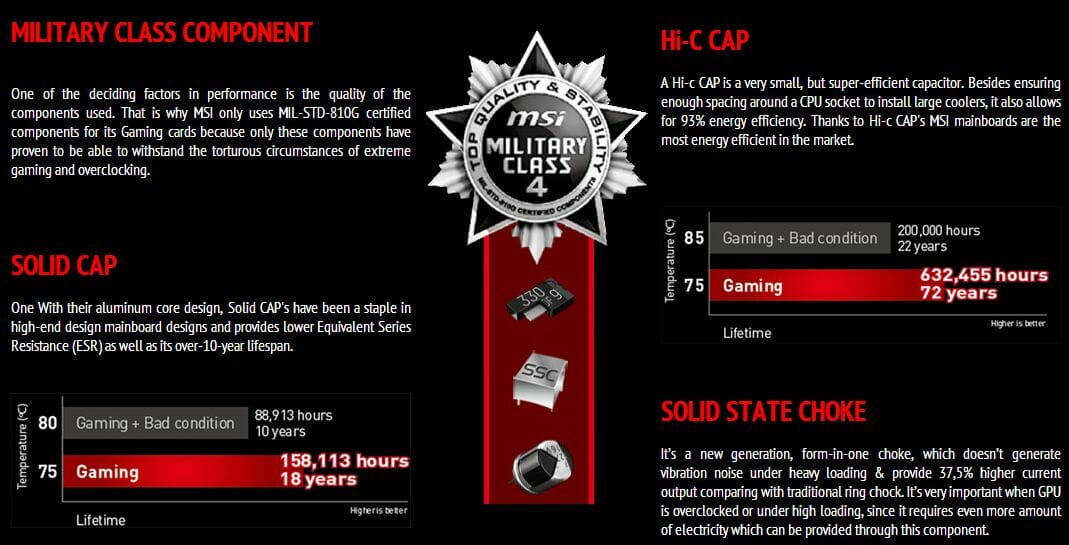
The power system uses aluminum-core solid-state capacitors with ultra-low resistance and 10-year service life, economical (93% efficient) Hi-c capacitors and Super Ferrite Chokes with 20% higher energy efficiency and 30% higher current capacity compared to ordinary chokes.
The GPU voltage regulator is based on an IOR 3563B controller from International Rectifier.
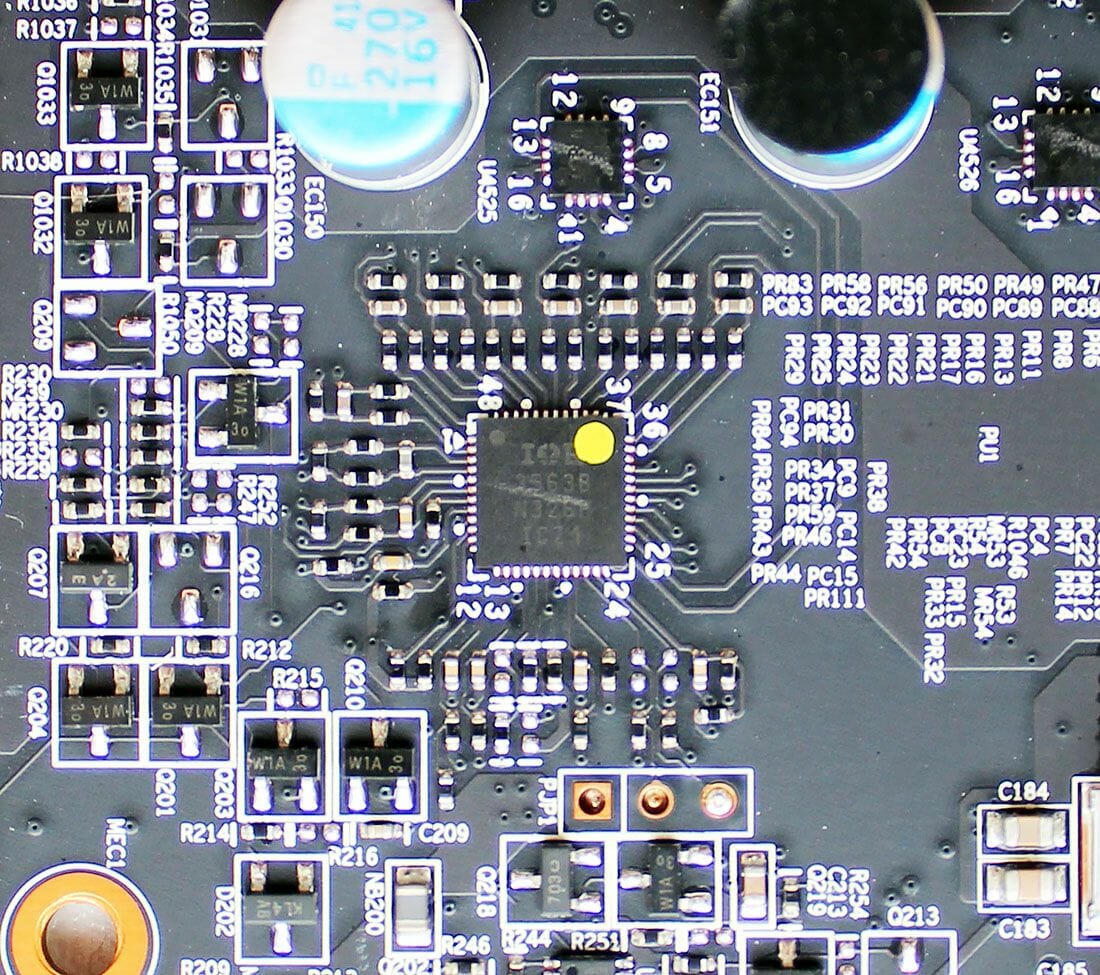
It is an 8-phase I2C-compliant controller which supports voltage adjustment for power savings or overclocking. The latest beta version of the MSI Afterburner utility already allows you to tweak the GPU voltage of this Radeon R9 280.
The GPU is a regular 28nm Tahiti chip manufactured in Taiwan.
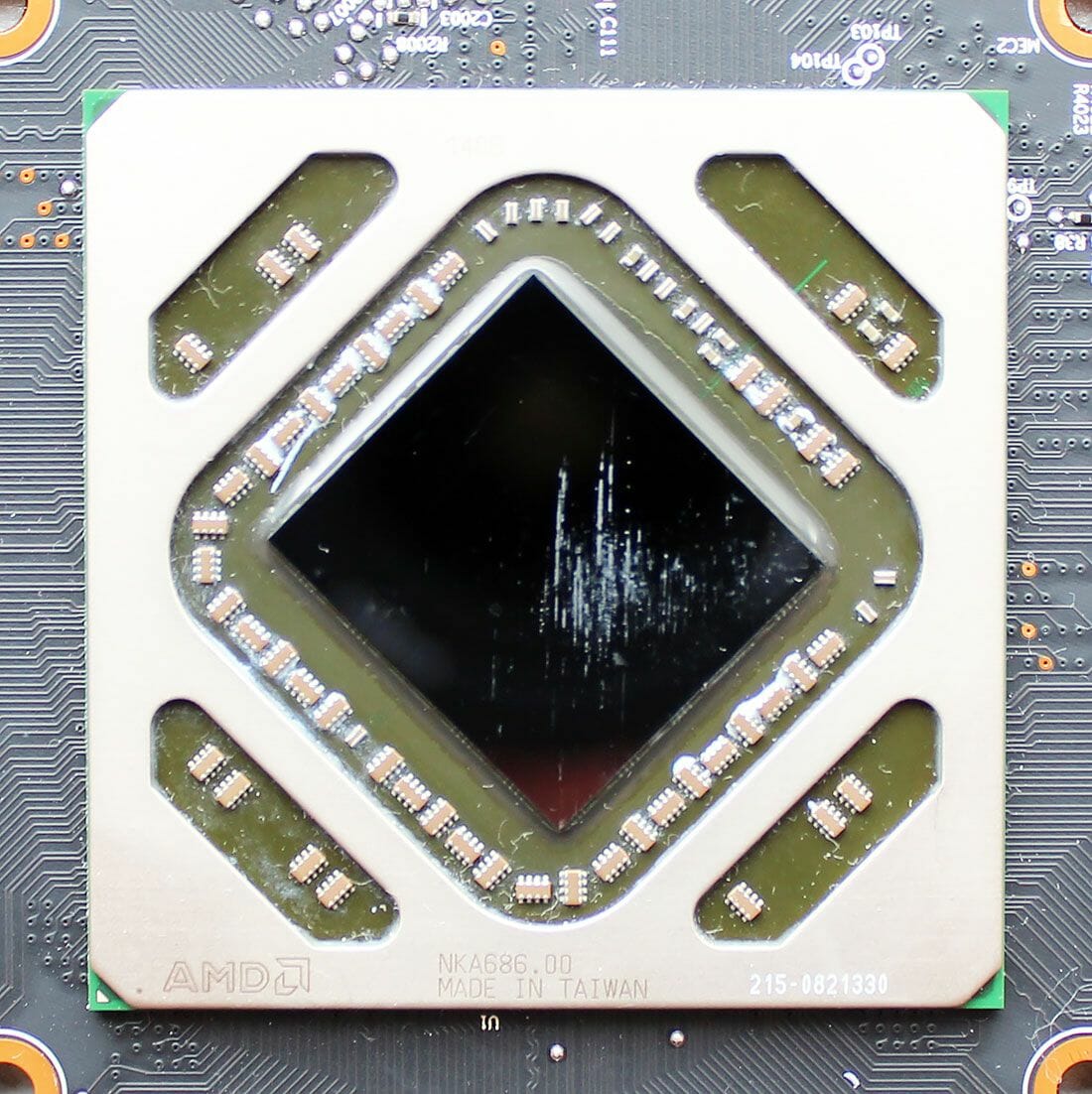
The GPU die is 352 sq. mm large, incorporating about 4313 million transistors. It contains 1792 unified shader processors, 112 texture-mapping units and 32 raster operators. There’s no difference from the reference Radeon HD 7950 in this respect. The clock rate can be as high as 933 MHz instead of the older card’s 800 MHz. Moreover, the GPU clock rate is not strictly specified by AMD, so the graphics card makers have already released a lot of pre-overclocked versions.
The MSI Radeon R9 280 Gaming can have a GPU frequency of 933, 972 or 1000 MHz depending on the operation mode you select in MSI Gaming App. If you don’t install that app and don’t choose any of the three available GPU/cooler presets, the graphics card will clock its GPU at 972 MHz at peak loads. In 2D applications the frequency is dropped to 300 MHz and the voltage is reduced, too.
The ASIC quality of our sample of the MSI Radeon R9 280 Gaming is very low at only 59.7%.
The graphics card has 3 gigabytes of GDDR5 memory in 12 FCBGA-packaged chips soldered to the face side of its PCB. These are H5GQ2H24AFR T2C chips from SK Hynix.
The memory chips are clocked at their rated frequency of 5000 MHz (the frequency is dropped to 600 MHz in 2D applications). Coupled with the 384-bit bus, the peak memory bandwidth is 240 GB/s. So, the Radeon R9 280 is no different from the Radeon HD 7950 in terms of graphics memory.
Cooling System: Efficiency and Noise Level
The MSI Radeon R9 280 Gaming is equipped with MSI’s exclusive Twin Frozr IV Advanced cooler.
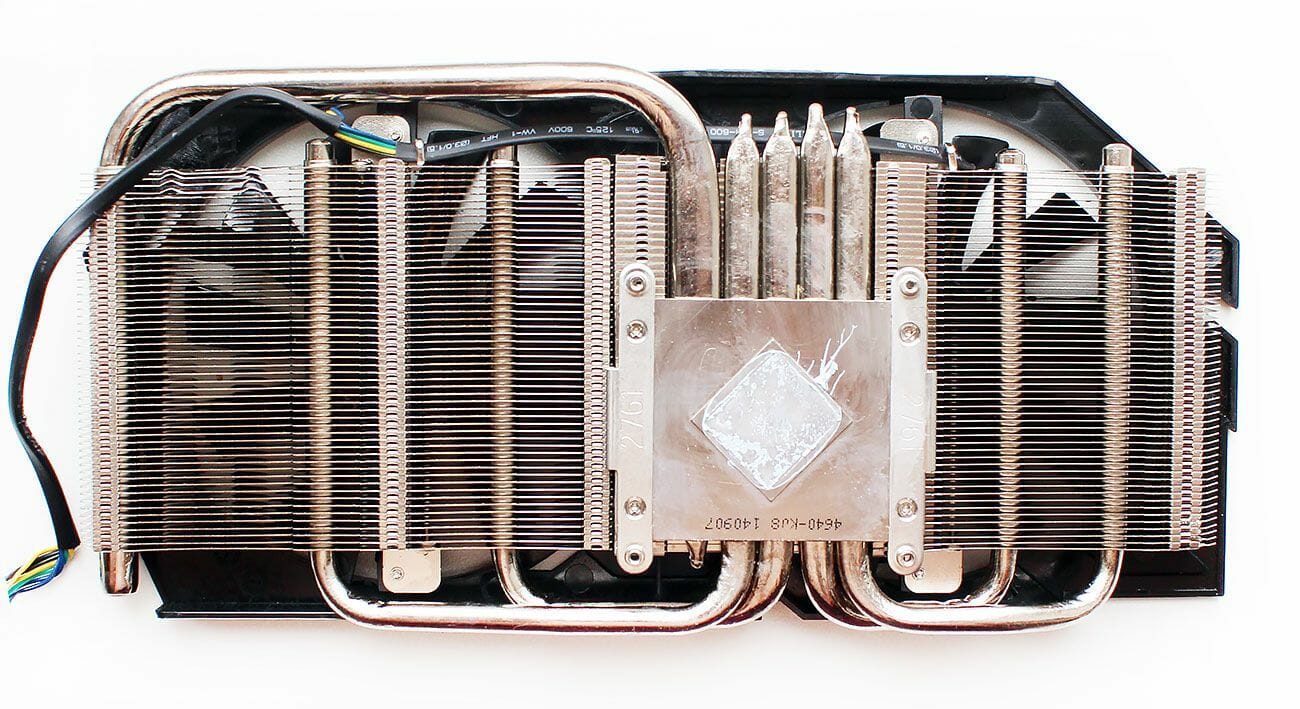
It is the same cooler as is installed on the MSI Radeon R9 280X Gaming.
The nickel-plated aluminum heatsink is pierced by five heat pipes that go out of the cooler’s copper base. Four of the pipes are 6 mm in diameter and one pipe is 8 mm in diameter.
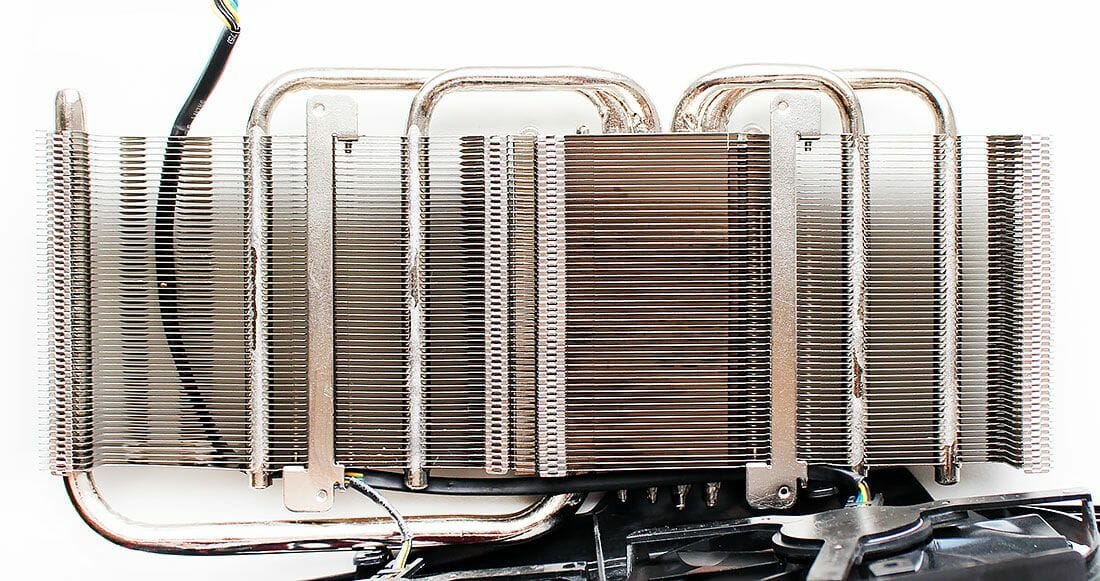
The Twin Frozr IV Advanced features SuperPipes with twice the heat-transfer capacity of ordinary heat pipes. The pipes, heatsink fins and base are all soldered to each other. There’s a special GPU contact spot on the cooler’s base.
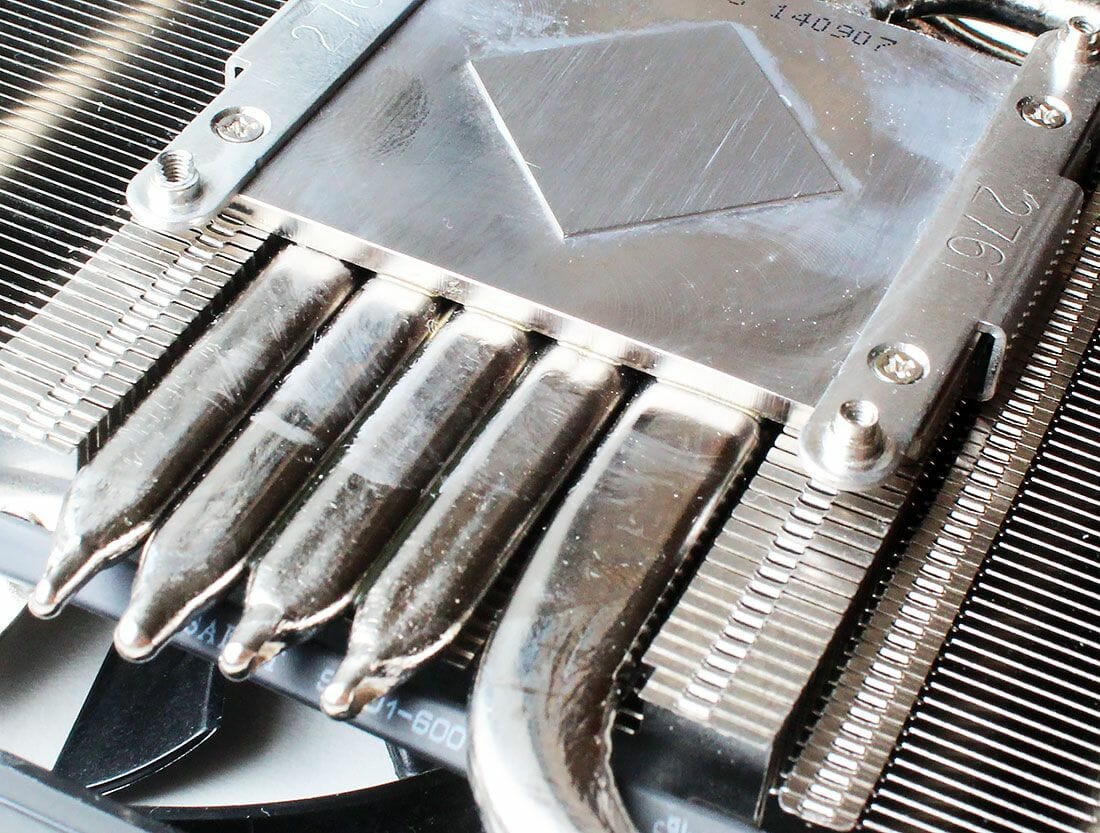
The card’s memory, excepting one chip, is cooled by a metallic plate with thermal pads. A black-painted aluminum heatsink is mounted on the power system components.
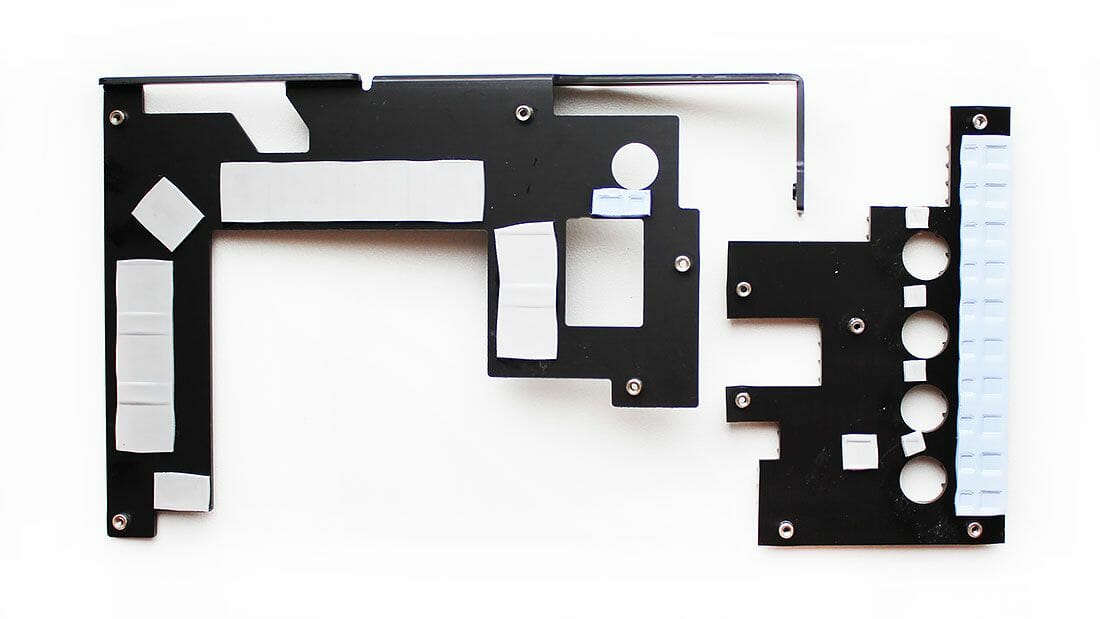
The cooler has two 100mm fans (the actual size of the impeller is 93 mm) with Propeller Blade technology (thanks to the slanted edges of the blades, the fans are supposed to create higher pressure at lower noise). These Power Logic fans are marked as PLD10010S12HH.
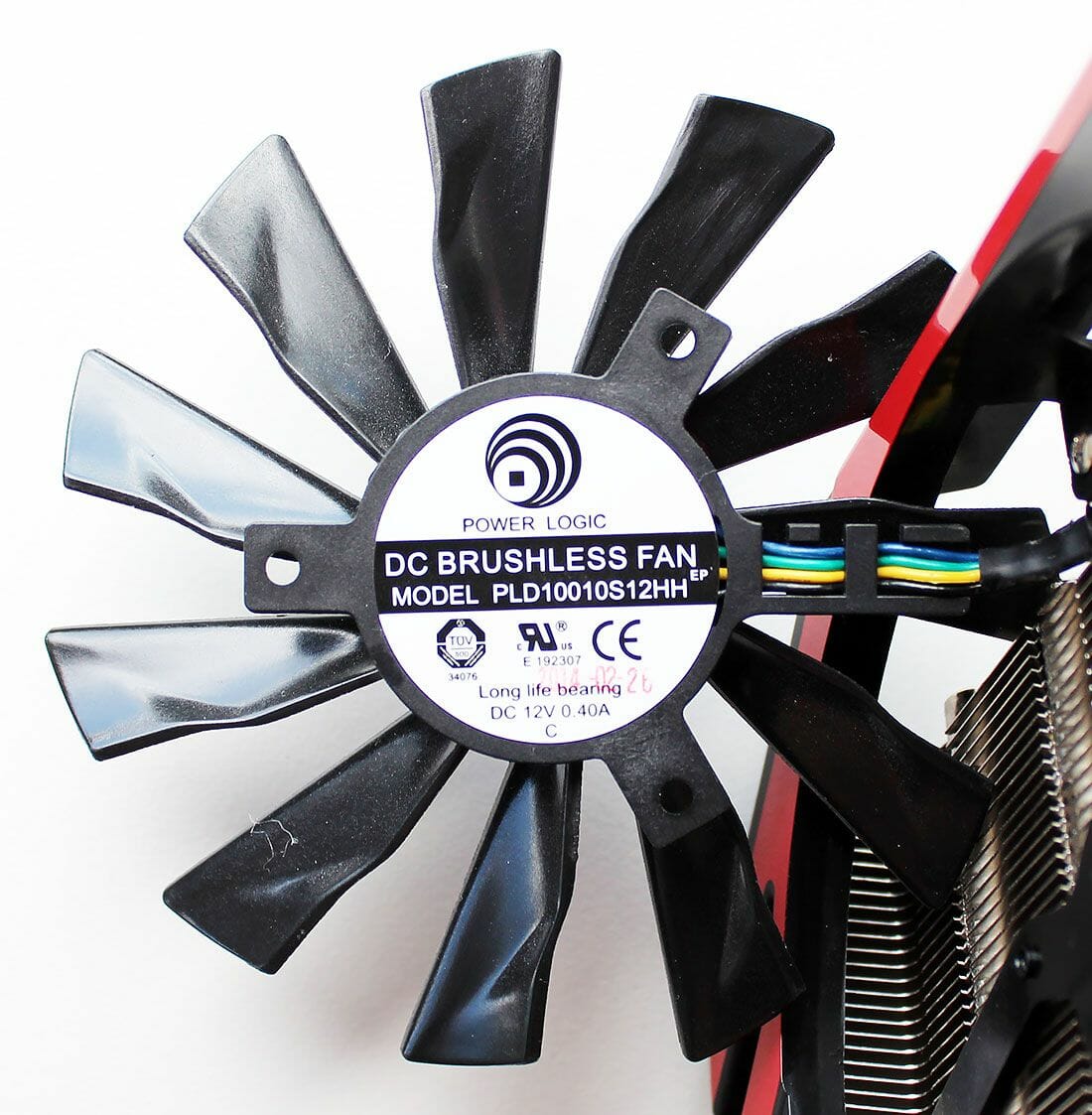
According to the marking, the fans run on fluid-dynamic bearings, yet their service life is not specified in their specs. The speed of the fans, according to our monitoring tools, is PWM-regulated in a range of 920 to 3040 RPM. There is no highlighting.
To measure the temperature of the graphics card we ran Aliens vs. Predator (2010) five times at the maximum visual quality settings, at a resolution of 2560×1440 pixels, with 16x anisotropic filtering and with 4x MSAA.
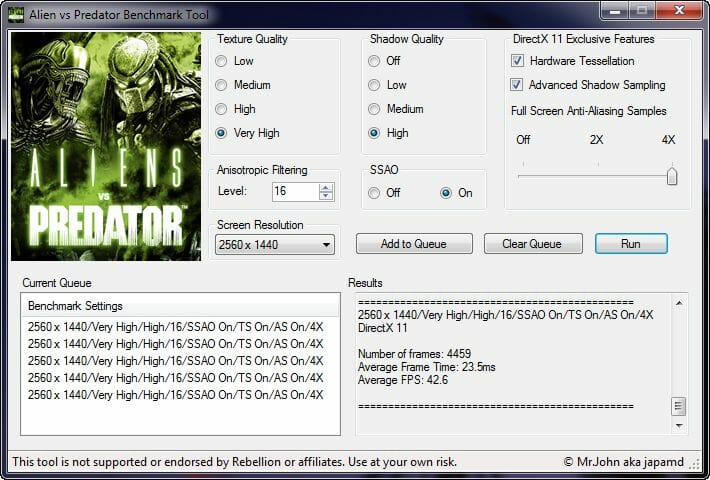
We used MSI Afterburner 3.0.0 and GPU-Z version 0.7.8 to monitor temperatures inside the closed computer case. The computer’s configuration is detailed in the following section of our review. All tests were performed at 25°C room temperature.
The Twin Frozr IV Advanced once again proved its high performance even with its fans regulated automatically.
Auto fans speed mode
The peak GPU temperature of 79°C is rather high, but we should note that the fans are never faster than 1720 RPM. It is quite a comfortable level of noise.
And if cooling performance is your top priority, you can manually set the fans at their maximum speed and drop the temperature by 12°C.
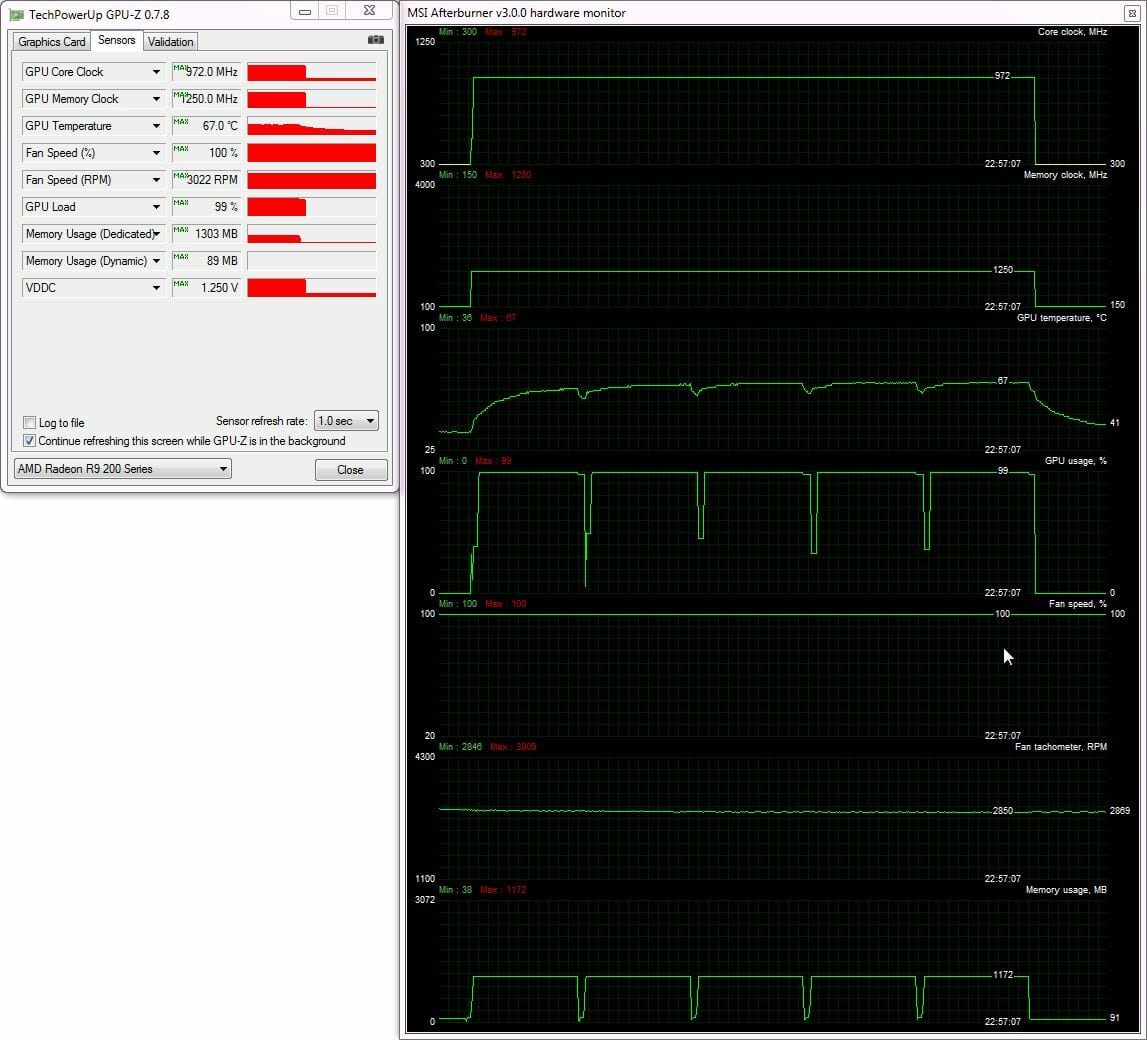
So, the cooler doesn’t give you a cause to worry about overheat. Let’s see how noisy it is, though.
We measured the level of noise using an electronic noise-level meter CENTER-321 in a closed and quiet room about 20 sq. meters large. The noise-level meter was set on a tripod at a distance of 15 centimeters from the graphics card which was installed on an open testbed. The mainboard with the graphics card was placed at an edge of a desk on a foam-rubber tray. The bottom limit of our noise-level meter is 29.8 dBA whereas the subjectively comfortable (not low, but comfortable) level of noise, when measured from that distance, is about 36 dBA. The speed of the graphics card’s fans was being adjusted by means of a controller that changed the supply voltage in steps of 0.5 V.
In our noise level test we will compare the MSI Radeon R9 280 Gaming with the original cards MSI Radeon R9 280X Gaming, Gigabyte GeForce GTX 760 OC WindForce 3X and EVGA GeForce GTX 760 Dual FTW ACX. The vertical dotted lines mark the top speed of the coolers’ fans in the automatic regulation mode.
The noise level graphs of the MSI Radeon R9 280 Gaming and MSI Radeon R9 280X Gaming are very close to each other because these cards have identical coolers. Yet the R9 280 Gaming is quieter because its fans work at lower speeds when regulated automatically. The new card is quieter in 2D mode too, so we suppose that the fan regulation algorithm has been additionally optimized for it.
Compared to its opponents, the new card from MSI is better than the EVGA GeForce GTX 760 Dual FTW ACX but worse than the Gigabyte GeForce GTX 760 OC WindForce 3X. Overall, we are quite satisfied with the noise level of the MSI Radeon R9 280 Gaming.
Overclocking Potential
As many overclockers will remember, even if a Radeon HD 7950 could not be unlocked to the Radeon HD 7970 level, it might be overclocked to bridge the gap. Our sample of the MSI Radeon R9 280 Gaming did very well in this respect. We managed to increase its GPU clock rate by 20.4% (198 MHz) and its memory clock rate by as much as 40% (2000 MHz)!
The resulting clock rates were 1170/7000 MHz, which is much higher than the default clock rates of any original Radeon R9 280X.
We hope our overclocking can make up for the lack of shader processors and texture-mapping units in the Tahiti GPU and help it beat the Radeon R9 280X. Let’s see what temperature the overclocked card has with its fans regulated automatically:
The GPU has got 3°C hotter, up to 82°C. The top speed of the fans is 340 RPM higher at 2060 RPM.
Testbed and Methods
Here is the list of components we use in our testbed.
- Mainboard: Intel Siler DX79SR (Intel X79 Express, LGA2011, BIOS 0594 dated 06.08.2013)
- CPU: Intel Core i7-3970X Extreme Edition 3.5/4.0 GHz (Sandy Bridge-E, C2, 1.1 V, 6x256KB L2 cache, 15MB L3 cache)
- CPU cooler: Phanteks PH-TC14PЕ (2×900 RPM)
- Thermal grease: ARCTIC MX-4
- Graphics cards:
- EVGA GeForce GTX 770 Superclocked ACX 2GB (1111-1163/7012 MHz)
- MSI Radeon R9 280X Gaming 3GB (1050/6000 MHz)
- MSI Radeon R9 280 Gaming 3GB (972/5000 and 1170/7000 MHz)
- Gigabyte GeForce GTX 760 OC WindForce 3X 4GB (1085-1150/6008 MHz)
- MSI Radeon R9 270X Gaming (4GB, 1120/5600 MHz)
- System memory: DDR3 4x8GB G.SKILL TridentX F3-2133C9Q-32GTX (XMP: 2133 MHz, 9-11-11-31, 1.6 volts)
- System disk: SSD 256GB Crucial m4 (SATA 6 Gbit/s, CT256M4SSD2, BIOS v070H)
- Games/software disk: Western Digital VelociRaptor (SATA-2, 300 GB, 10000 RPM, 16MB cache, NCQ) in a Scythe Quiet Drive 3.5″ enclosure
- Backup disk: Samsung EcoGreen F4 HD204UI (SATA-2, 2 TB, 5400 RPM, 32 MB cache, NCQ)
- Sound card: Auzen X-Fi HomeTheater HD
- Computer case: Antec Twelve Hundred (front panel: three Noiseblocker NB-Multiframe S-Series MF12-S2 fans at 1020 RPM; back panel: two Noiseblocker NB-BlackSilentPRO PL-1 fans at 1020 RPM; top panel: one preinstalled 200mm fan at 400 RPM)
- Control & monitoring panel: Zalman ZM-MFC3
- Power supply: Corsair AX1200i (1200 W), 120mm fan
- Monitor: 27″ Samsung S27A850D (DVI-I, 2560×1440, 60 Hz)
We’ll compare the MSI Radeon R9 280 Gaming 3GB with an MSI Radeon R9 280X Gaming 3GB as the next step up the performance ladder. The Nvidia camp will be represented by an EVGA GeForce GTX 770 Superclocked ACX 2GB.
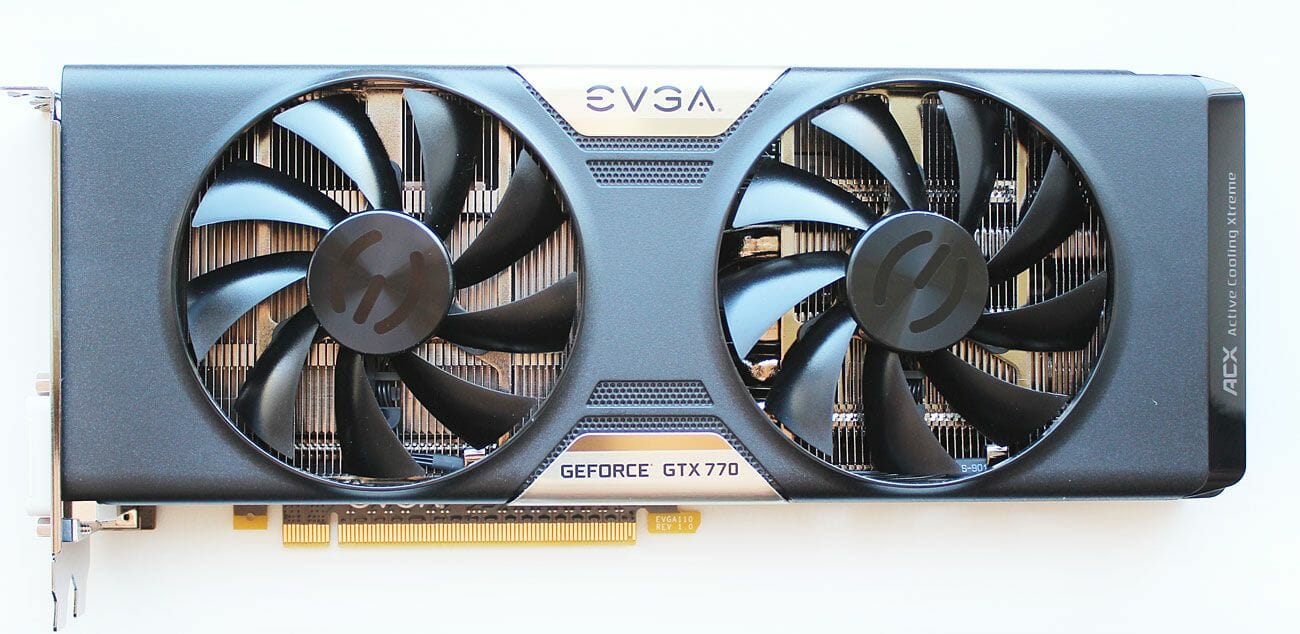
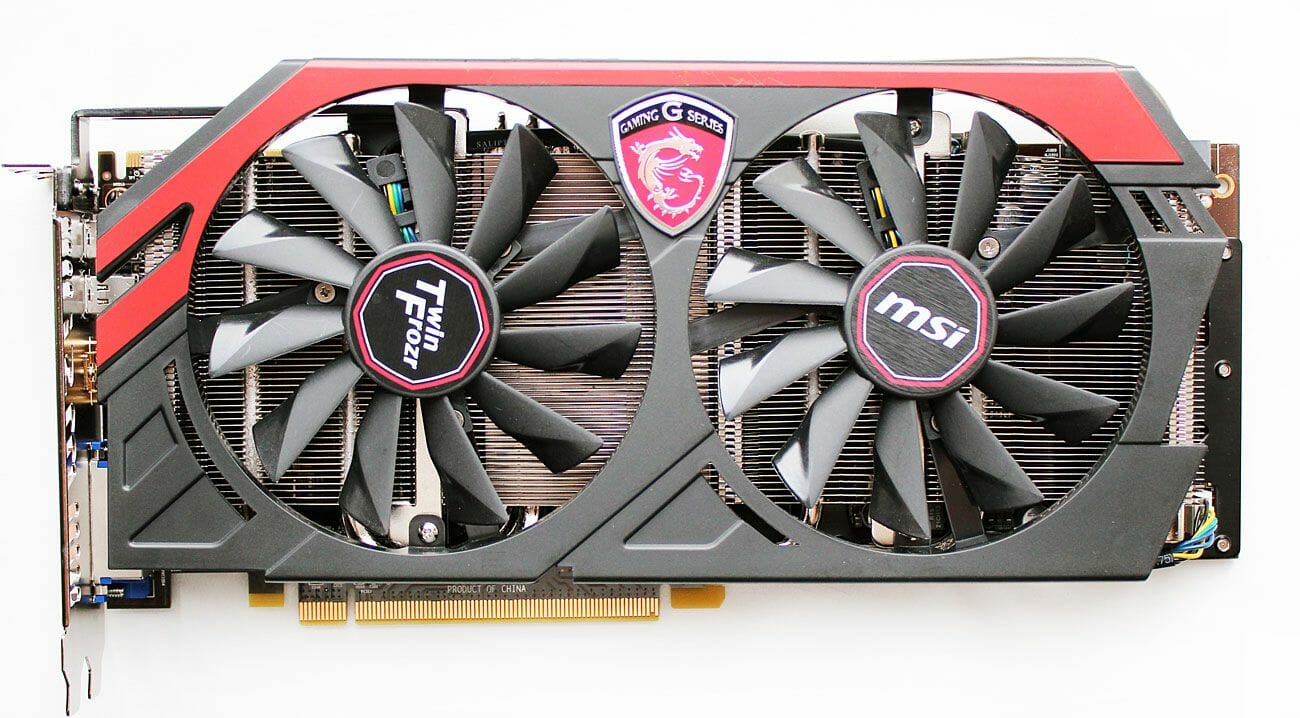
There will also be a Gigabyte GeForce GTX 760 OC WindForce 3X with 4GB of onboard memory which is priced comparably to the Radeon R9 280. And we’ll also throw in an MSI Radeon R9 270X Gaming with 4GB of memory as the junior product in this class.
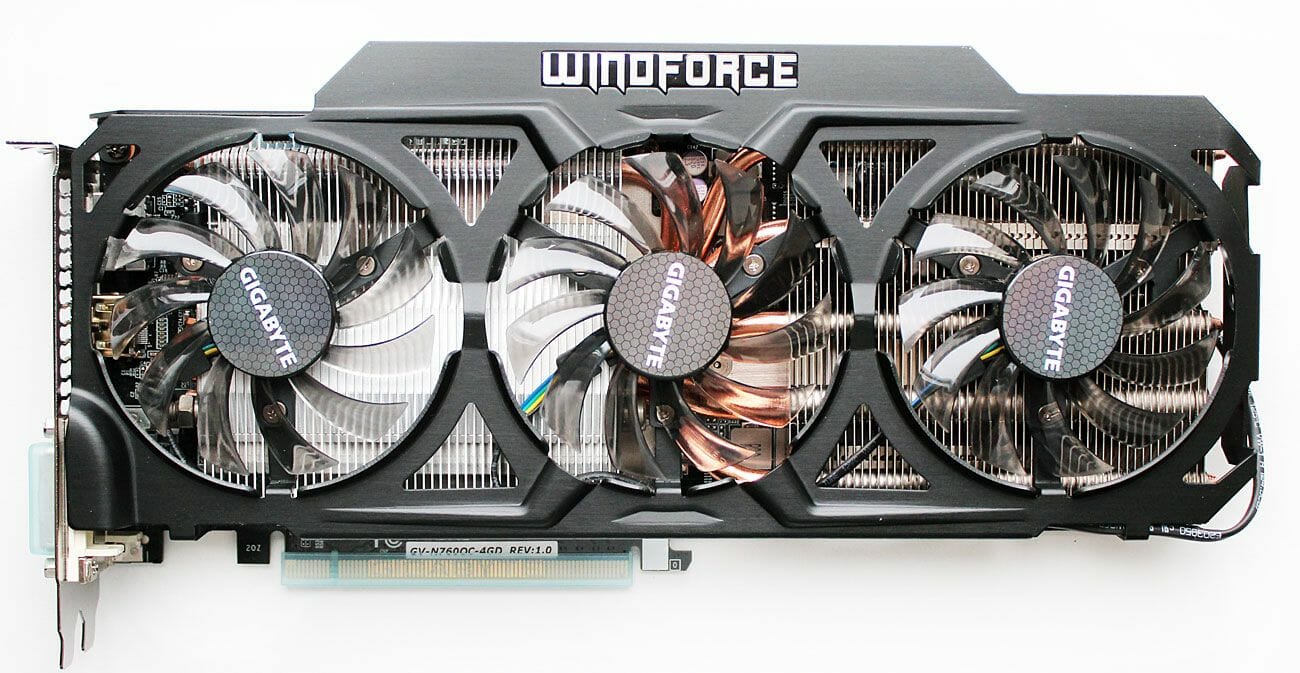
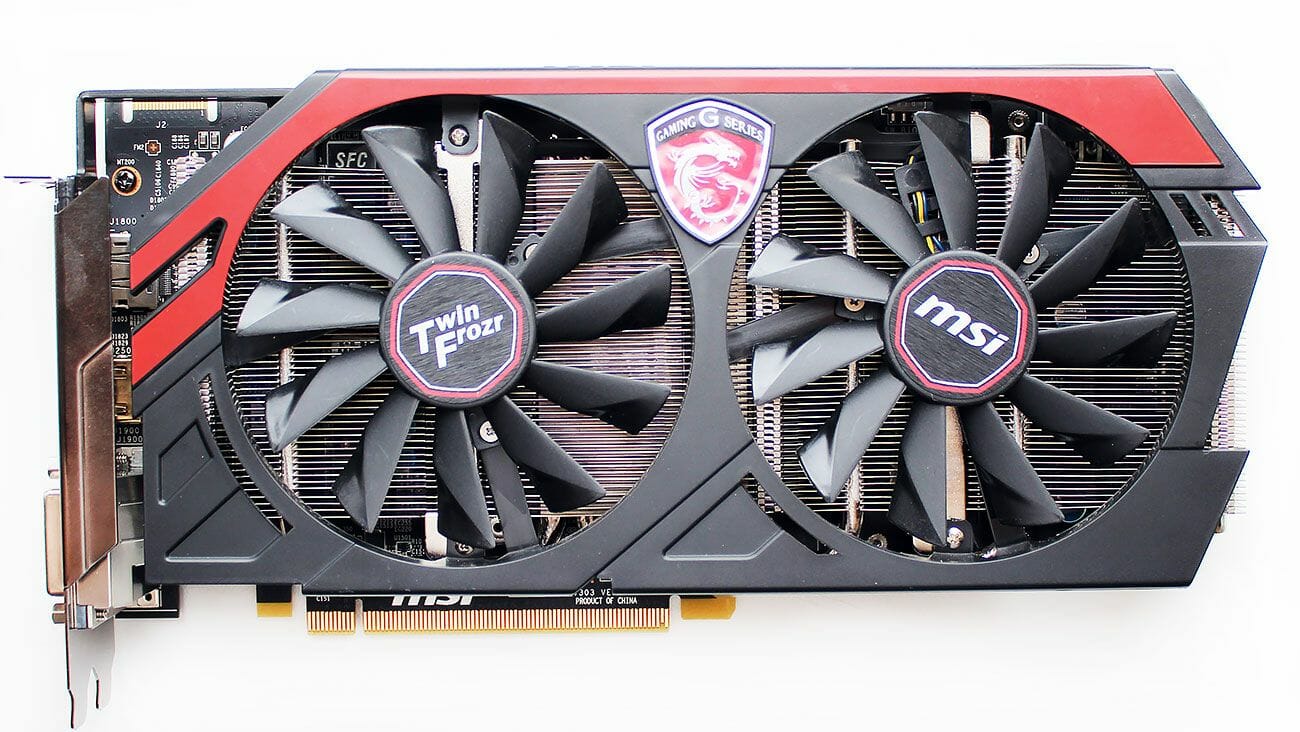
We set Power Limit at its maximum on each graphics card.
In order to lower the dependence of the graphics cards’ performance on the overall platform speed, we overclocked our 32nm six-core CPU to 4.8 GHz by setting its frequency multiplier at x48 and enabling Load-Line Calibration. The CPU voltage was increased to 1.385 volts in the mainboard’s BIOS.
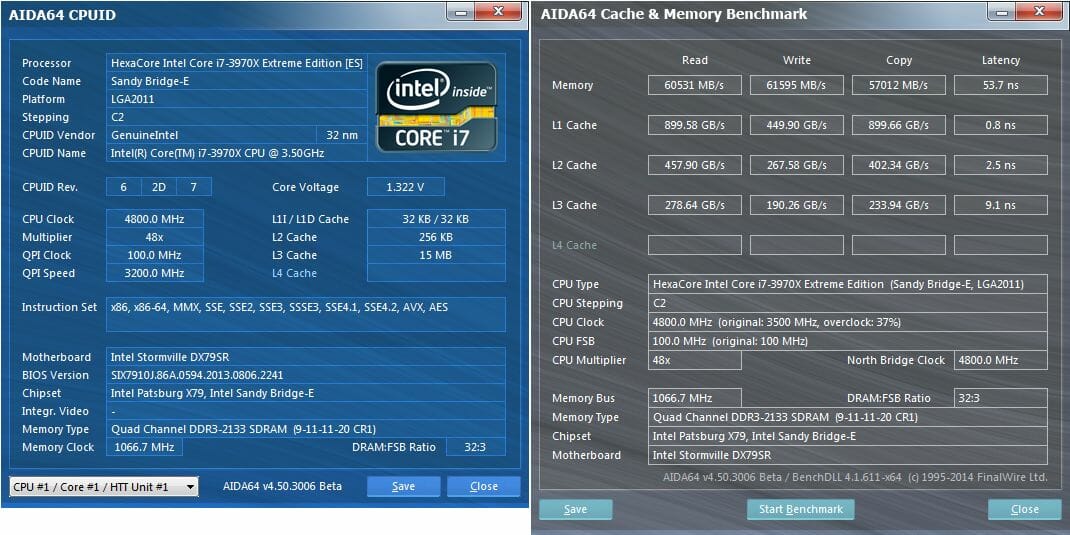
Hyper-Threading was turned on. We used 32 GB of system memory at 2.133 GHz with timings of 9-11-11-20_CR1 and voltage of 1.6125 volts.
The testbed ran Microsoft Windows 7 Ultimate x64 SP1 with all critical updates installed. We used the following drivers:
- Intel Chipset Drivers – 9.4.4.1006 WHQL dated 21.09.2013
- DirectX End-User Runtimes, dated 30 November 2010
- AMD Catalyst 14.6 Beta (14.100.0.0) dated 27.05.2014
- Nvidia GeForce 337.88 WHQL dated 26.05.2014
Other driver versions may be found in some of the GPU-Z screenshots in this review, but we took those screenshots from other articles only to compare the graphics cards’ specs.
We benchmarked the graphics cards’ performance at two display resolutions: 1920×1080 and 2560×1440 pixels. There were two visual quality modes: “Quality+AF16x” means the default texturing quality in the drivers + 16x anisotropic filtering whereas “Quality+ AF16x+MSAA 4x(8x)” means 16x anisotropic filtering and 4x or 8x antialiasing. In some games we use antialiasing algorithms other than MSAA as indicated below and in the diagrams. We enabled anisotropic filtering and full-screen antialiasing from the game’s menu. If the corresponding options were missing, we changed these settings in the Control Panels of the Catalyst and GeForce drivers. We also disabled V-Sync there. There were no other changes in the driver settings.
The graphics cards were tested in two benchmarks and 14 games updated to the latest versions.
- 3DMark (2013) (DirectX 9/11) version 1.3.708: Cloud Gate, Fire Strike and Fire Strike Extreme scenes.
- Unigine Valley Bench (DirectX 11) version 1.0: Maximum visual quality settings, 16x AF and/or 4x MSAA, 1920×1080.
- Total War: SHOGUN 2 – Fall of the Samurai (DirectX 11) version 1.1.0: integrated benchmark (the Sekigahara battle) with maximum visual quality settings and 8x MSAA.
- Sniper Elite V2 Benchmark (DirectX 11) version 1.05: Adrenaline Sniper Elite V2 Benchmark Tool v1.0.0.2 BETA with maximum graphics quality settings (“Ultra” profile), Advanced Shadows: HIGH, Ambient Occlusion: ON, Stereo 3D: OFF, Supersampling: OFF, two sequential runs of the test.
- Sleeping Dogs (DirectX 11) version 1.5: Adrenaline Sleeping Dogs Benchmark Tool v1.0.2.1 with maximum image quality settings, Hi-Res Textures pack installed, FPS Limiter and V-Sync disabled, two consecutive runs of the built-in benchmark with quality antialiasing at Normal and Extreme levels.
- Hitman: Absolution (DirectX 11) version 1.0.447.0: built-in test with Ultra settings, enabled tessellation, FXAA and global lighting.
- Crysis 3 (DirectX 11) version 1.2.0.1000: maximum visual quality settings, Motion Blur – Medium, lens flares – on, FXAA and MSAA 4x, two consecutive runs of a scripted scene from the beginning of the “Swamp” mission (110 seconds long).
- Tomb Raider (2013) (DirectX 11) version 1.1.748.0: we used Adrenaline Benchmark Tool, all image quality settings set to “Ultra”, V-Sync disabled, FXAA and 2x SSAA antialiasing enabled, TessFX technology activated, two consecutive runs of the in-game benchmark.
- BioShock Infinite (DirectX 11) version 1.1.25.5165: we used Adrenaline Action Benchmark Tool with “Ultra” and “Ultra+DOF” quality settings, two consecutive runs of the in-game benchmark.
- Metro: Last Light (DirectX 11) version 1.0.0.15: we used the built-in benchmark for two consecutive runs of the D6 scene. All image quality and tessellation settings were at “Very High”, Advanced PhysX technology enabled, with and without SSAA antialiasing.
- GRID 2 (DirectX 11) version 1.0.85.8679: we used the built-in benchmark, the visual quality settings were all at their maximums, the tests were run with and without MSAA 8x antialiasing with eight cars on the Chicago track.
- Company of Heroes 2 (DirectX 11) version 3.0.0.13946: two consecutive runs of the integrated benchmark at maximum image quality and physics effects settings.
- Total War: Rome II (DirectX 11) version 1.11.0.0: Extreme quality, V-Sync disabled, SSAA enabled, two consecutive runs of the integrated benchmark.
- Batman: Arkham Origins (DirectX 11) version 1.0 update 8: Ultra visual quality, V-Sync disabled, all the effects enabled, all DX11 Enhanced features enabled, Hardware Accelerated PhysX = Normal, two consecutive runs of the in-game benchmark.
- Battlefield 4 (DirectX 11) – version 111433: Ultra settings, two successive runs of a scripted scene from the beginning of the “Tashgar” mission (110 seconds long), with the Mantle API enabled for AMD-based cards.
- Thief (DirectX 11) version 1.5 build 4158.5: Maximum visual quality settings, Parallax Occlusion Mapping and Tessellation enabled, a double run of the in-game benchmark with the Mantle API enabled for AMD-based cards.
We publish the bottom frame rate for games that report it. Each test was run twice, the final result being the best of the two if they differed by less than 1%. If we had a larger difference, we reran the test at least once again to get repeatable results.
Performance
The results of the Nvidia-based cards, EVGA GeForce GTX 770 Superclocked ACX and Gigabyte GeForce GTX 760 OC WindForce 3X, are colored light-green in the diagrams below. The trio of MSI’s Radeon R9 Gaming products is colored red. The color of the MSI Radeon R9 280 Gaming in overclocked mode is lilac. The graphics cards are sorted in the order of descending retail price. Let’s get started!
3DMark (2013)
The MSI Radeon R9 280 Gaming easily outperforms the MSI Radeon R9 270X Gaming as well as its main opponent GeForce GTX 760 (represented by a rather fast original version from Gigabyte). It is 13.6% behind the MSI Radeon R9 280X Gaming but beats the latter when overclocked. Unigine Valley Bench
Our graphics cards differ more in this benchmark:
The MSI Radeon R9 280 Gaming can only compete with the Gigabyte GeForce GTX 760 OC WindForce 3X when antialiasing is turned on. It also takes a position right in between the R9 280X and R9 270X models from the same Gaming series. Overclocked to 1170/7000 MHz, the MSI Radeon R9 280 Gaming becomes the fastest of the AMD-based products and second only to the EVGA GeForce GTX 770 Superclocked ACX.
Total War: SHOGUN 2 – Fall of the Samurai
The standings are overall the same in this game as in the previous benchmark.
Sniper Elite V2 Benchmark
The new card from MSI can only compete with the Gigabyte GeForce GTX 760 OC WindForce 3X when overclocked because Nvidia-based solutions are generally superior to their AMD-based opponents in this game.
We can also note that the MSI Radeon R9 280 Gaming fits perfectly between the Radeon R9 280X Gaming and the Radeon R9 270X Gaming. The new model is just what AMD has been lacking in its product range.
Sleeping Dogs
In this test the MSI Radeon R9 280 Gaming is comparable to the Gigabyte GeForce GTX 760 OC WindForce 3X in three out of the four test modes but goes ahead by 16.7% in the hardest mode. When overclocked, the MSI Radeon R9 280 Gaming easily catches up with the MSI Radeon R9 280X Gaming and the EVGA GeForce GTX 770 Superclocked ACX.
Hitman: Absolution
The MSI Radeon R9 280 Gaming enjoys an even larger advantage over its opponent in this game:
It beats the Gigabyte easily and leaves the MSI Radeon R9 270X Gaming behind by up to 22%. It is also up to 15% slower than the MSI Radeon R9 280X Gaming but becomes an undisputed leader when overclocked.
Crysis 3
We have the same standings here as in the previous game:
Tomb Raider (2013)
Like in Hitman: Absolution, AMD beats Nvidia in every product category here.
BioShock Infinite
Once again the MSI Radeon R9 280 Gaming fits perfectly in between the Radeon R9 280X Gaming and the R9 270X Gaming.
The Gigabyte GeForce GTX 760 OC WindForce 3X has the same average frame rate although is slower in terms of bottom speed, which is a peculiarity of the in-game benchmark. Our overclocking makes the MSI Radeon R9 280 Gaming substantially faster, so it can outperform the Radeon R9 280X Gaming and catch up with the leader EVGA GeForce GTX 770 Superclocked ACX.
Metro: Last Light
The Nvidia-based products are superior in this game with Advanced PhysX enabled but we can still note that the MSI Radeon R9 280 Gaming fits perfectly between its two cousins from the same Gaming series.
Turning off Advanced PhysX increases the frame rate of AMD-based cards in Metro: Last Light.Now the standings are typical of this test session.
GRID 2
The GRID 2 results are interesting because the Gigabyte GeForce GTX 760 OC WindForce 3X, being an opponent to the MSI Radeon R9 280 Gaming, actually competes with the MSI Radeon R9 270X Gaming and cannot match the more advanced AMD-based models. The EVGA GeForce GTX 770 Superclocked ACX is expectedly faster than the Gigabyte, yet slower than the MSI Radeon R9 280X Gaming as well as the overclocked MSI Radeon R9 280 Gaming.
Company of Heroes 2
This game is sensitive to the amount of graphics memory, therefore we have different standings than in the previous games.
The Nvidia-based products fall behind their AMD counterparts in each class, the 4GB Gigabyte GeForce GTX 760 OC WindForce 3X being just a little slower than the 2GB EVGA GeForce GTX 770 Superclocked ACX and even having higher bottom speed in three out of the four test modes. Equipped with 4 GB of onboard memory, the MSI Radeon R9 270X Gaming is almost as fast as the MSI Radeon R9 280 Gaming while the latter is comparable to the MSI Radeon R9 280X Gaming.
Total War: Rome II
The AMD-based products are superior to their Nvidia-based opponents in this game, the MSI Gaming trio having the same relative standings as in most of the previous tests.
Batman: Arkham Origins
We can see a typical picture with 8x MSAA turned on. When we turn it off, however, the Nvidia-based products have an advantage.Still, the R9 Gaming series trio have the same relative standings as before.
Battlefield 4
The MSI Radeon R9 280 Gaming performs very well here, too.14 to 19% faster than the MSI Radeon R9 270X Gaming, the new card is also ahead of the Gigabyte GeForce GTX 760 OC WindForce 3X. It is 11-15% slower than the Radeon R9 280X Gaming but beats the latter and the more expensive EVGA GeForce GTX 770 Superclocked ACX when overclocked.
Thief
MSI’s R9 Gaming series score another win over their opponents in Thief.Here’s a table with the full test results showing the overall average and bottom speed for each graphics card.
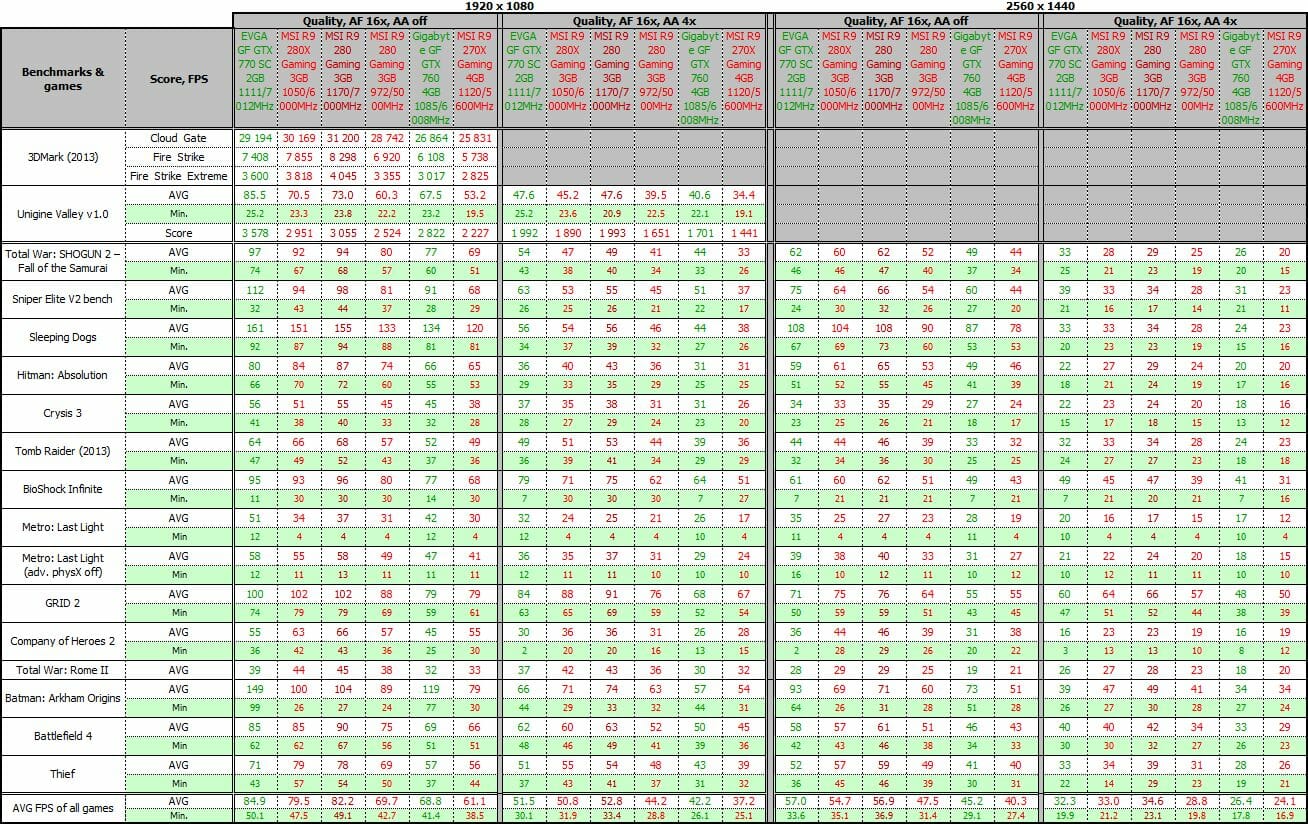
Now we can move on to our summary charts.
Performance Summary
First of all, let’s see how faster the MSI Radeon R9 280 Gaming 3GB is in comparison with the MSI Radeon R9 270X 4GB, the latter serving as a baseline.
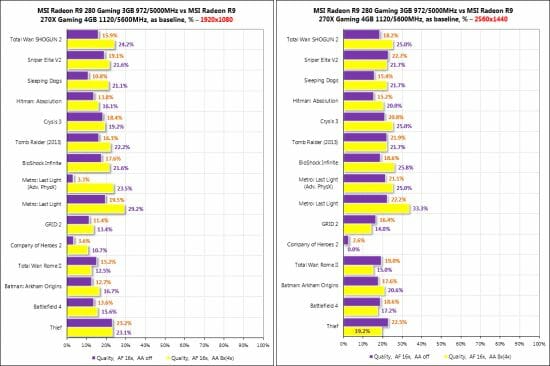
The MSI Radeon R9 280 Gaming is an average 14.3-19.4% faster than the R9 280X at 1920×1080 and 18.2-20.4% faster at 2560×1440 pixels. The price difference between the two cards is about 20%, matching the difference in their performance.
The AMD Radeon R9 280 is positioned as an opponent to Nvidia’s GeForce GTX 760, so we’ll compare them in the next summary charts. The GTX 760 is represented by the pre-overclocked Gigabyte GeForce GTX 760 OC WindForce 3X (1085-1150/6008 MHz) with as much as 4 GB of graphics memory but the MSI Radeon R9 280 Gaming is pre-overclocked as well. Here are the results.
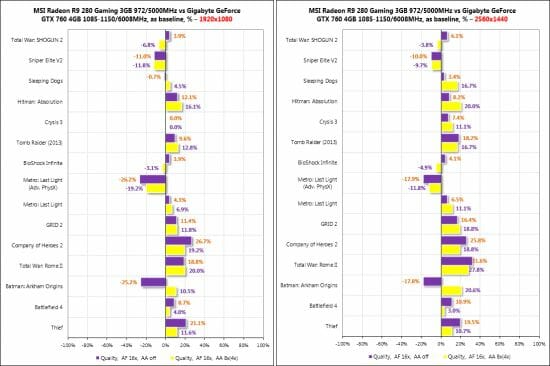
The GeForce GTX 760 doesn’t have many wins against the Radeon R9 280: Sniper Elite V2, Metro: Last Light (with Advanced PhysX enabled), and Batman: Arkham Origins (without antialiasing). The MSI Radeon R9 280 Gaming, in its turn, wins in Hitman: Absolution, Tomb Raider, Metro: Last Light, GRID 2, Company of Heroes 2, Total War: Rome II, Battlefield 4, Thief, and in the high-quality test modes of Sleeping Dogs, Crysis 3 and Batman: Arkham Origins. It is clear the Radeon R9 280 is somewhat faster than the GeForce GTX 760 overall. Its advantage amounts to 4-5% at 1920×1080 and to 8-9% at 2560×1440 across all the tests.
The next charts help compare the MSI Radeon R9 280 Gaming and the MSI Radeon R9 280X Gaming.
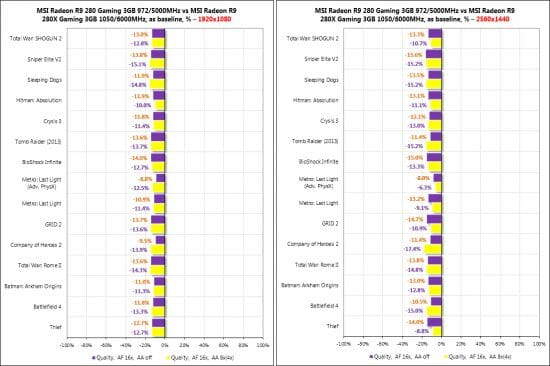
The full-featured Tahiti core of the MSI Radeon R9 280X Gaming working at a higher clock rate and its faster memory make it superior to the MSI Radeon R9 280 Gaming. The gap is smaller than between the MSI Radeon R9 280 Gaming and the MSI Radeon R9 270X Gaming, though. The average difference is 12-13%, which isn’t very large.
This difference can be easily covered by overclocking the MSI Radeon R9 280 Gaming. We managed to increase the GPU and memory clock rates by 20.4% (to 1170 MHz) and 40% (to 7000 MHz), respectively, so the overclocked card beat its senior cousin in the majority of our tests.
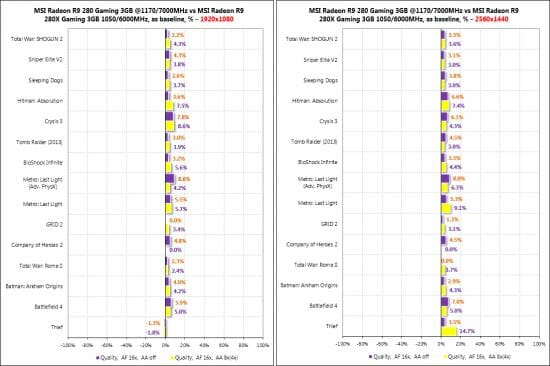
Of course, the MSI Radeon R9 280X Gaming can be overclocked as well, but this review is all about the Radeon R9 280 without any X’s.
Power Consumption
We measured the power consumption of computer systems with different graphics cards using a multifunctional panel Zalman ZM-MFC3 which can report how much power a computer (the monitor not included) draws from a wall socket. There were two test modes: 2D (editing documents in Microsoft Word and web surfing) and 3D (the intro scene of the Swamp level from Crysis 3 running four times in a loop at 2560×1440 with maximum visual quality settings but without MSAA). Here are the results:
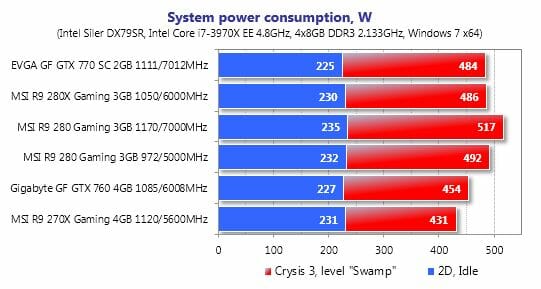
Interestingly, the MSI Radeon R9 280 Gaming configuration needs somewhat more power than the same configuration with an MSI Radeon R9 280X Gaming. It must be due to some differences in their PCB designs and/or measurement inaccuracies. The difference is a mere 0.8% and may be easily neglected. When the MSI Radeon R9 280 Gaming is overclocked, the power draw rises by 26 watts, still staying within AMD’s recommended 550-watt limit.
Conclusion
The AMD Radeon R9 280 comes at a recommended $249 and beats the GeForce GTX 760 in the majority of tests. It is 20% faster than the Radeon R9 270X and only 13% slower than the Radeon R9 280X. And it can be easily overclocked to beat its more advanced cousin. All in all, we guess it has everything it takes to become a bestseller in the midrange segment.
The MSI Radeon R9 280 Gaming is a well-implemented version of the new graphics card which features an efficient cooler, factory GPU overclocking, premium components, high frequency potential and a 3-year warranty. We hope that other brands will release just as attractive Radeon R9 280 cards of their own.